Physical Address
304 North Cardinal St.
Dorchester Center, MA 02124
The external approach for rhinoplasty is found almost exclusively in the severely twisted or previously operated nose.
Nasofrontal angle modifications can help shorten or lengthen the nasal dorsum.
Batten grafts can help correct both internal and external nasal valve collapse.
Spreader grafts are helpful both structurally and cosmetically and can increase the internal nasal valve area.
Upper lateral cartilage (ULC) turn-in flaps and auto-spreader grafts can be used to stabilize the middle vault but have not proven to be structurally sound enough to repair the crooked nose.
The septum must be straightened to correct a severely twisted nasal deformity.
The saddle nose deformity is best augmented with autogenous materials such as septal, auricular, or costal cartilage.
In general, the non-Caucasian nose has thick skin; weak cartilage; a flat, broad dorsum; an underprojected, poorly defined tip; and a wide alar base.
In the unilateral cleft nasal deformity , the nasal tip and columella are deviated toward the noncleft side, the nasal floor is widened, and the cleft nostril is wider than that of the noncleft side.
In the bilateral cleft nasal deformity , the columella is short and is deviated to the less involved side.
In both types of nasal cleft deformities, the tip is poorly defined and bifid, and the alar base is displaced laterally, posteriorly, and inferiorly in relation to the noncleft side.
Reconstruction of the cleft lip nasal deformity is based on improving the symmetry of the nasal tip and base and improving the nasal airway.
Aesthetic and reconstructive rhinoplasty is considered to be the most challenging and difficult of all facial plastic procedures and arguably one of the most difficult procedures to achieve consistent and acceptable results. Every rhinoplasty is unique and presents the surgeon with a diversity of challenges, for which he or she must have a variety of specialized techniques to address each patient's anatomic and functional deformities. This chapter addresses some of the less common nasal deformities and the surgical techniques that can be used to correct them. These deformities require the inclusion of all aspects of combined septorhinoplasty, with frequent extension and modification of several techniques. The cases are particularly challenging in regard to improving the airway and gaining maximum improvement in appearance. A form of combined septorhinoplasty that corrects both internal and external nasal deformities in one stage is essential. The chapter focuses on modifications of the septum, nasofrontal angle, and nasal tip while detailing the principles and techniques needed to correct the twisted nose, the saddle nose, the non-Caucasian nose, and the cleft-lip nose.
A thorough examination, involving observation, visual inspection externally and internally, and detailed palpation of the nose, is essential in determining preoperatively which anatomic components are actually involved in the nasal deformity. Experience is an important factor in doing this at the time of the office examination. Careful examination should be coordinated with appropriate photographs, radiograph films, and facial analysis. The preoperative findings strongly influence the selection of the most appropriate surgical approach and exposure techniques.
Coordination of the preoperative analysis with the findings at the operation table can be accomplished through either the standard intranasal rhinoplasty approaches or the external rhinoplasty approach. We use both the closed or standard rhinoplasty approaches and the external, open, or decorticate approach. The external approach is used almost universally in the twisted nose, the nose that requires implant materials, secondary rhinoplasty, and the cleft-lip nose.
External or decorticate rhinoplasty technique is the approach of choice when severe asymmetries, deviations, and tissue deficiencies are evident. Some of the indications for use of external rhinoplasty are: (1) when a nasal deformity is difficult to precisely analyze and diagnose; (2) when asymmetry of the nasal side walls and lower lateral cartilages (LLCs) is severe; (3) when tissue deficiencies exist that necessitate precisely placed and sutured implants ; (4) when there is a congenital anomaly, such as the cleft-lip nose or other deformities in which profound asymmetries exist; and (5) with an extremely wide bony and cartilaginous dorsum, regardless of whether a hump is removed. The external approach involves a transverse mid-columellar incision in a gull-wing fashion rather than an inverted gull-wing or stepped incision. We use the gull-wing incision, as opposed to the inverted gull-wing incision, to create a single point, rather than two points, at the distal end of a diffuse random-pattern flap. The incision is then extended upward along the caudal edge of the medial crus and laterally along the caudal margin of the lateral crus as an alar cartilage margin incision ( Fig. 32.1 ). The elevation is initiated with knife dissection, and the columella skin is elevated before the elevation is extended laterally over the lateral crura of the LLCs. The external incision that crosses the columella leaves a barely perceptible scar and offers excellent visualization by means of the “degloving” of the nose.
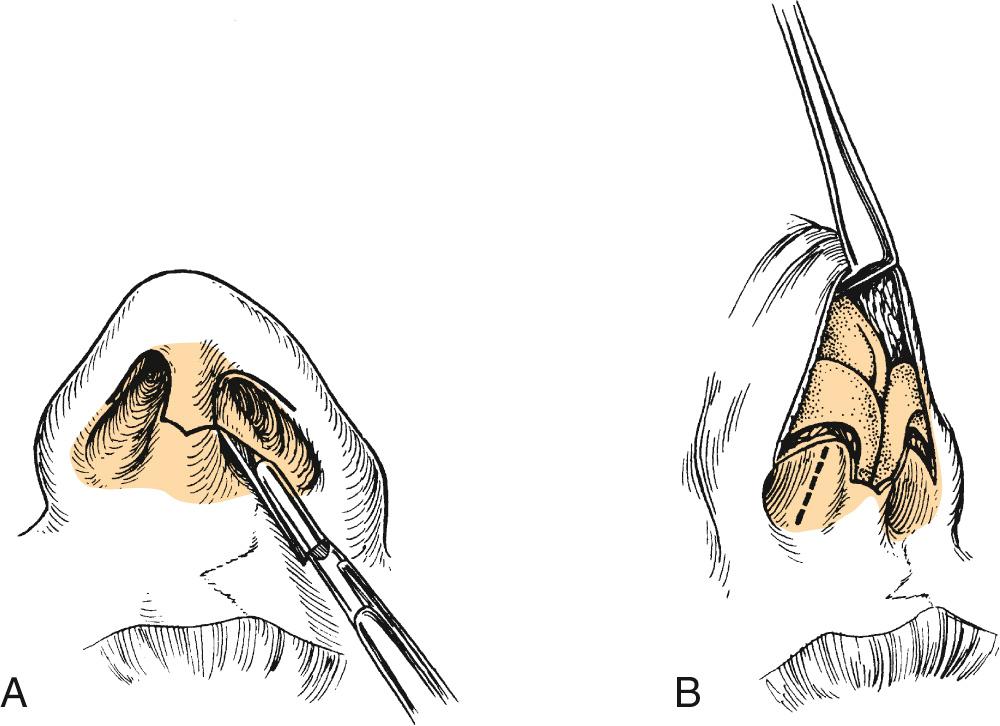
It is impossible to discuss correction of the difficult nasal deformity without addressing surgery of the involved septum. The specific techniques required are determined by the amount of cartilage that remains and how angulated or dislocated it is. The septum must be considered as an ideal donor site for cartilage and bone implants. When adequate material is available, it is excellent for the nasal dorsum, a columella strut, a tip graft, and caudal septal extension graft, as well as for creating spreader and batten grafts. If all these grafts are necessary for the desired outcome, then costal cartilage will be harvested.
Once the incisions are made, elevation of the mucoperichondrial flaps can be frequently difficult because of fibrosis through fracture sites, overlapping or lamination of the cartilage itself, or previous surgery. In the previously operated nose, a practical approach involves beginning the elevation of the mucoperichondrium beneath the dorsum because this area is often undisturbed. The elevation then proceeds downward toward the previous operative site, where cartilage and bone may have been removed. Elevation is easier from undisturbed segments of the septum, which are most often in the dorsal and posterior septum. Thus initiating the dissection high in the nose and bringing it inferior and anterior may provide a better plane of dissection. It will be necessary to release the upper lateral cartilages (ULCs) for adequate visualization.
It is typically necessary to elevate the mucoperichondrium on both sides of the septal cartilage. Freeing fibrous contractions and septal angulations is essential to allow the septal framework to straighten. Complete release of the mucoperichondrium and mucoperiostium from the septum allows mobility of the soft tissue for retrodisplacement in reduction rhinoplasty as well as anterior mobility for augmentation. The extent to which cartilage and bone must be removed or repositioned is dictated by the particular deformity encountered and the direction of the angulations. Generally, scoring or removal of thin strips of cartilage along the existing angulations is required to achieve straightening ( Fig. 32.2 ). Release of all tension vectors may allow a buckled septum to straighten. Determination of the final position of the septum may not be possible until osteotomies have been performed, particularly if the nasal bones and ULCs are severely deviated from the midline. Therefore a final determination of what more, if anything, needs to be done to the septum must sometimes await the completion of medial and lateral osteotomies, when the entire nose is positioned in the midline ( Fig. 32.3 ), as in the case of deviations of the central bony complex.
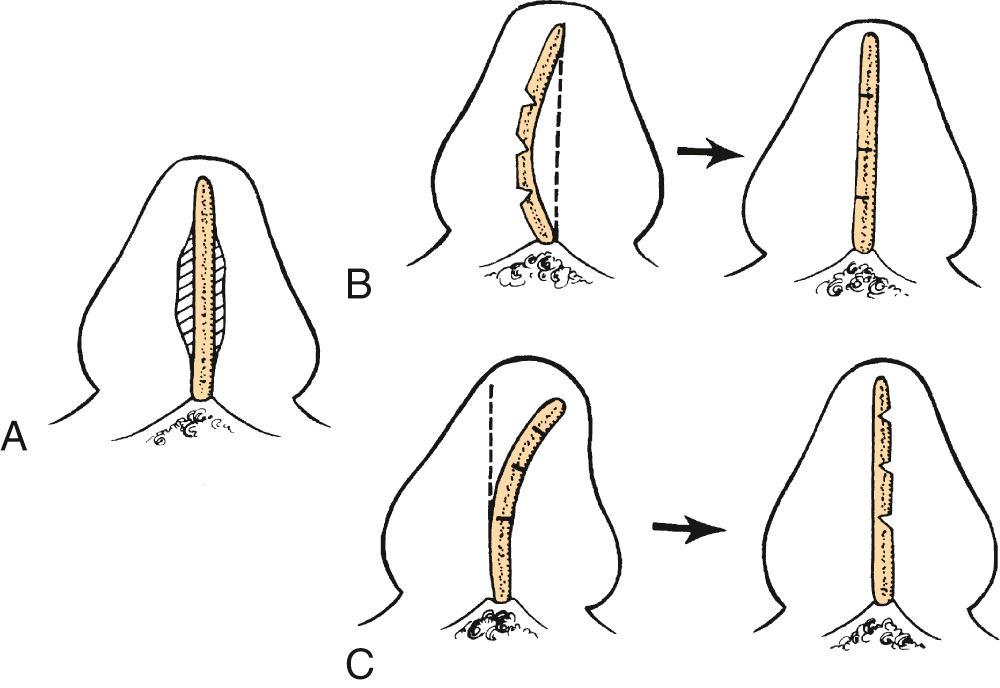

Transseptal coaptation sutures bring the two mucoperichondrial flaps together and pass between the angulations or cartilage pedicles to prevent overlap ( Fig. 32.4 ). Polyethylene splints have been used for several years to stabilize the septum in the early postoperative period and prevent the development of synechiae, particularly when turbinate surgery has been performed. Through-and-through sutures are placed through the polyethylene splints such that one arm of the suture goes between cartilage pedicles or beneath the septal cartilage for support and the second arm of the suture goes back through the mucoperichondrium and cartilage. This suture placement approximates the flaps to assist in the stabilization of the septal cartilage. The surgeon may splint the septum further at a major angulation with a straight portion of the thin perpendicular plate taken from the ethmoid.
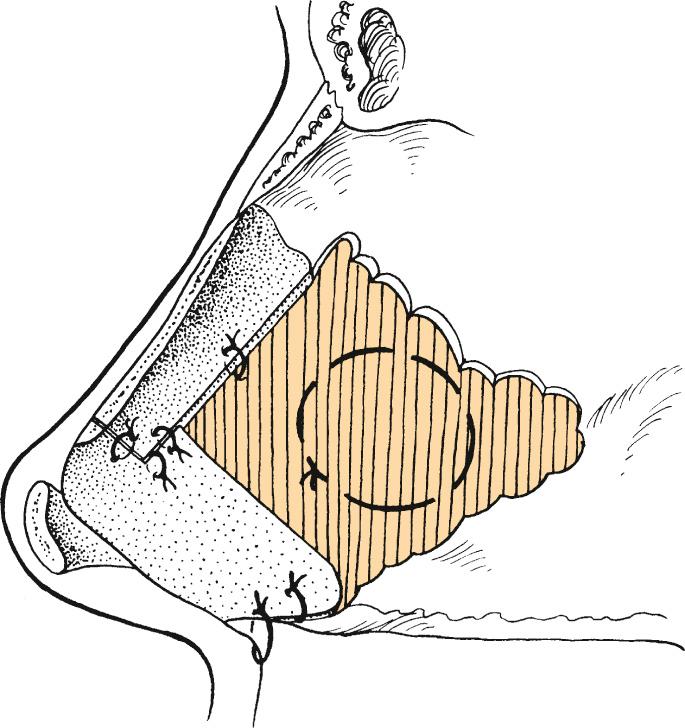
The septal cartilage is detached from the underlying anterior nasal spine and maxillary crest. Intrinsic tension of the septum is relieved by scoring, cross-hatching, and wedging. It may also be necessary to shorten the caudal strut to allow a tension-free reapproximation to the anterior maxillary spine. Once this caudal pedicle is freed of the tension vectors, it may be maintained in the midline by sutures that go around the anterior spine or through a burr hole in the spine ( Fig. 32.5 ). To further prevent dislocation, an additional suture may be passed through the two mucoperichondrial flaps and between the bone of the spine and the caudal strut. The cartilage pedicle is attached directly to the spine for alignment, and when sutured together, the two mucoperichondrial flaps add further stability. When necessary, the caudal edge of the septum may be held in proper relation to the columella with interrupted septocolumellar sutures ( Fig. 32.6 ).
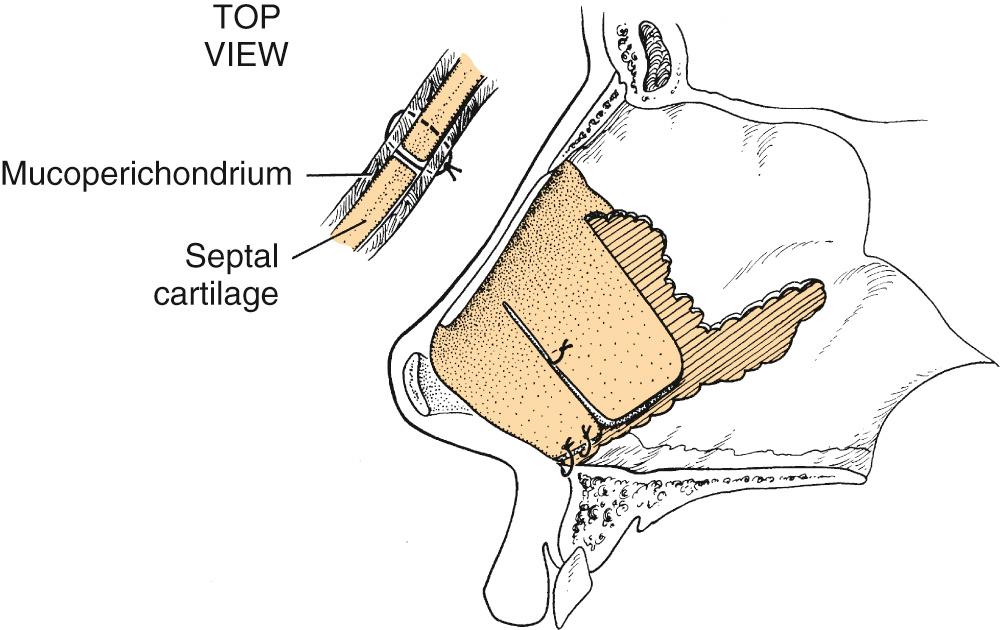
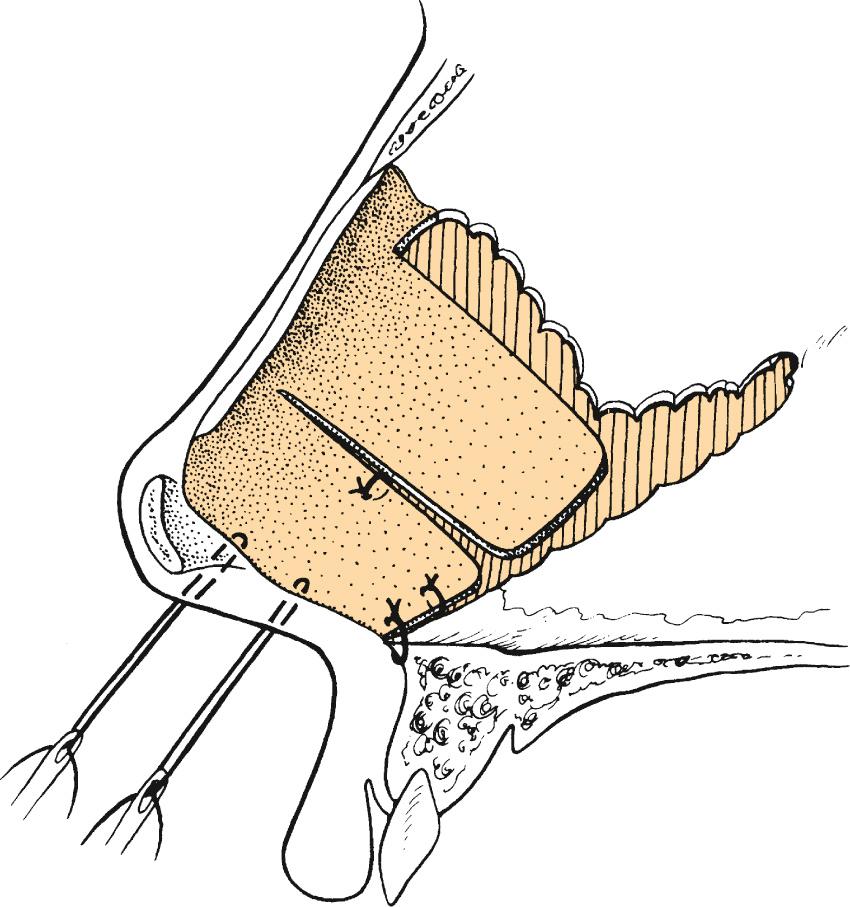
As a caveat, the caudal septum, if adequate and straight, is the best columellar strut with regard to strength, contour, and reliability. The first choice is to reposition the medial crura on the caudal septum rather than resecting the inferior margin of the septum. In correcting the drooping tip, the LLCs must be rotated cephalically, and a strong tip support is needed. Both the caudal septum and the soft tissue may need modification to achieve this ( Fig. 32.7 ).

Columellar retraction results in an acute nasolabial angle and the loss of tip support. Correction of the retraction requires straightening of the caudal septum and placement of a caudal septal extension graft, columellar strut, or a plumping graft ( Fig. 32.8 ). When the caudal edge of the septal cartilage is severely dislocated, it often creates distortion and retraction of the columella, even though adequate cartilage is present. Straightening and repositioning of the caudal septum within the columella sometimes correct the retraction ( Fig. 32.9 ).
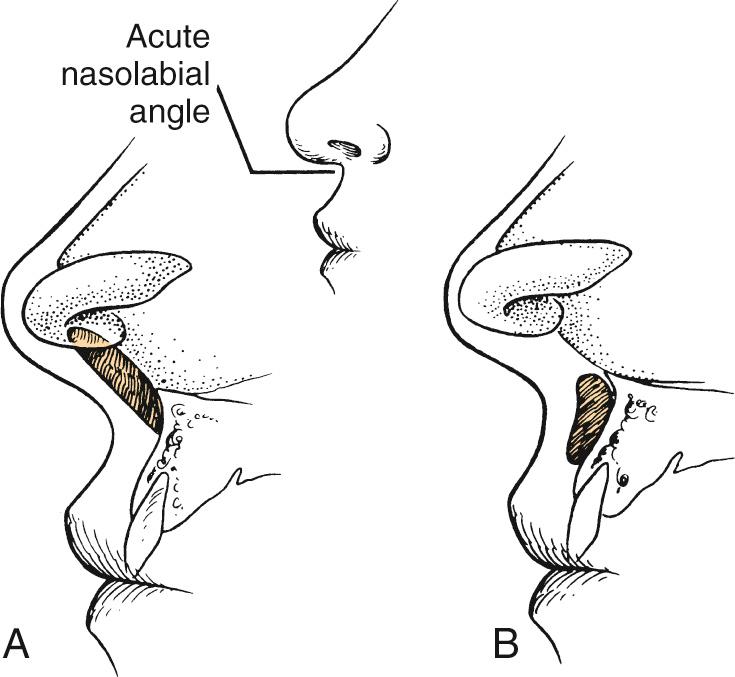
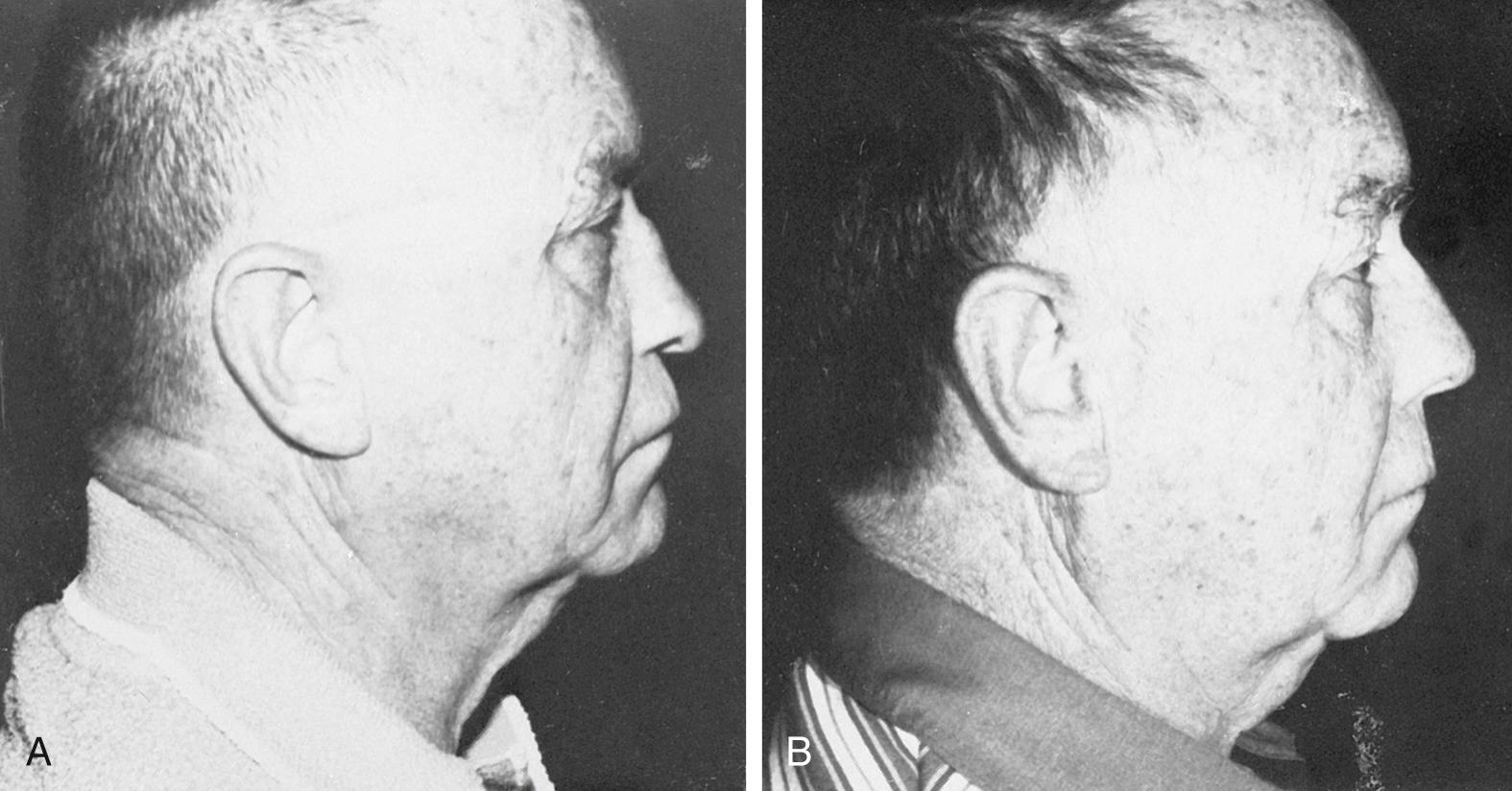
Once all septal reconstructive surgery and osteotomies have been completed, the final analysis of the position of the septum can be done. The position is particularly critical at the junction of the bony and cartilaginous portions of the nose, both internally and externally. If the cartilaginous dorsum has a tendency to sink inward, a draw suture can be passed through the skin to pick up either the septum alone or the ULCs and the septum along the dorsum ( Fig. 32.10 ). The suture is passed upward through the skin and is held in position, while all coapting and supporting sutures are placed and packing or internal splinting is completed. The draw suture can then be removed. In extreme cases, the draw suture can be passed through a thin external splint and tied over a bolus to remain in place for a week, until the splint is removed.
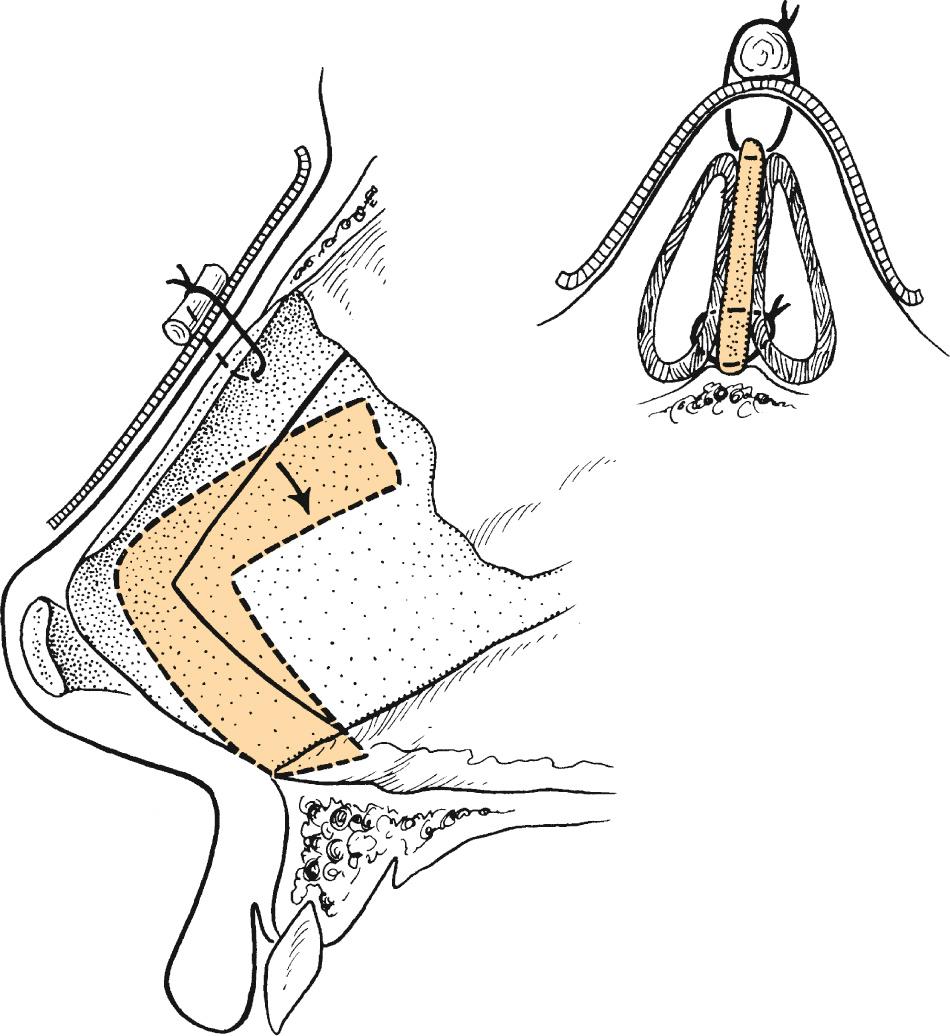
Columellar retraction may be present, caused by retraction of the caudal strut of the septum and may be exacerbated by the position of the alar margin. Ptotic LLCs with a convex caudal margin can cause increased columellar show; this may be exacerbated by a prominent caudal margin of the septum and/or an excessively membranous septum.
These deformities can be addressed by trimming or sculpturing the medial crura and caudal septum as demonstrated in Fig. 32.11 . Other structures that may contribute to the perceived or actual abnormalities of the caudal septum and columella include either ptosis of the lateral crus of the LLC, causing what appears to be a retracted columella, or retraction of the ala, resulting in excessive columellar show ( Fig. 32.12 ). These abnormalities must be corrected when addressing the LLCs, either through reduction or augmentation ( Fig. 32.13 ). Repositioning of the anterior maxillary spine, lateral crural repositioning, division of the depressor nasi musculi, sectioning of the frenulum, and defatting or augmentation of the nasolabial angle may also be necessary when addressing the caudal septum and columella.
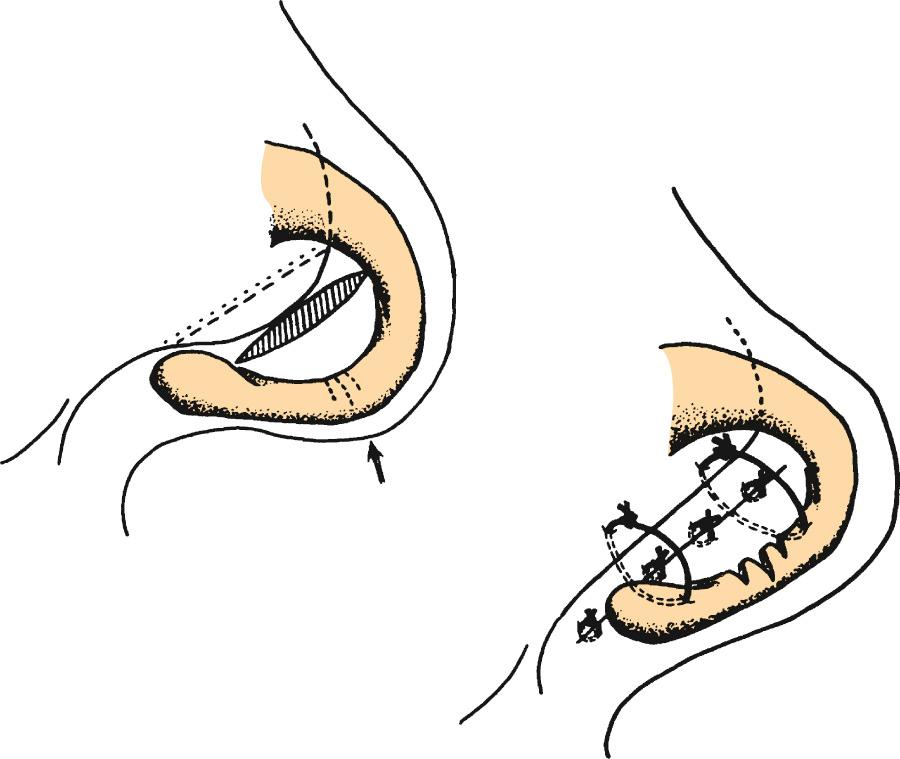
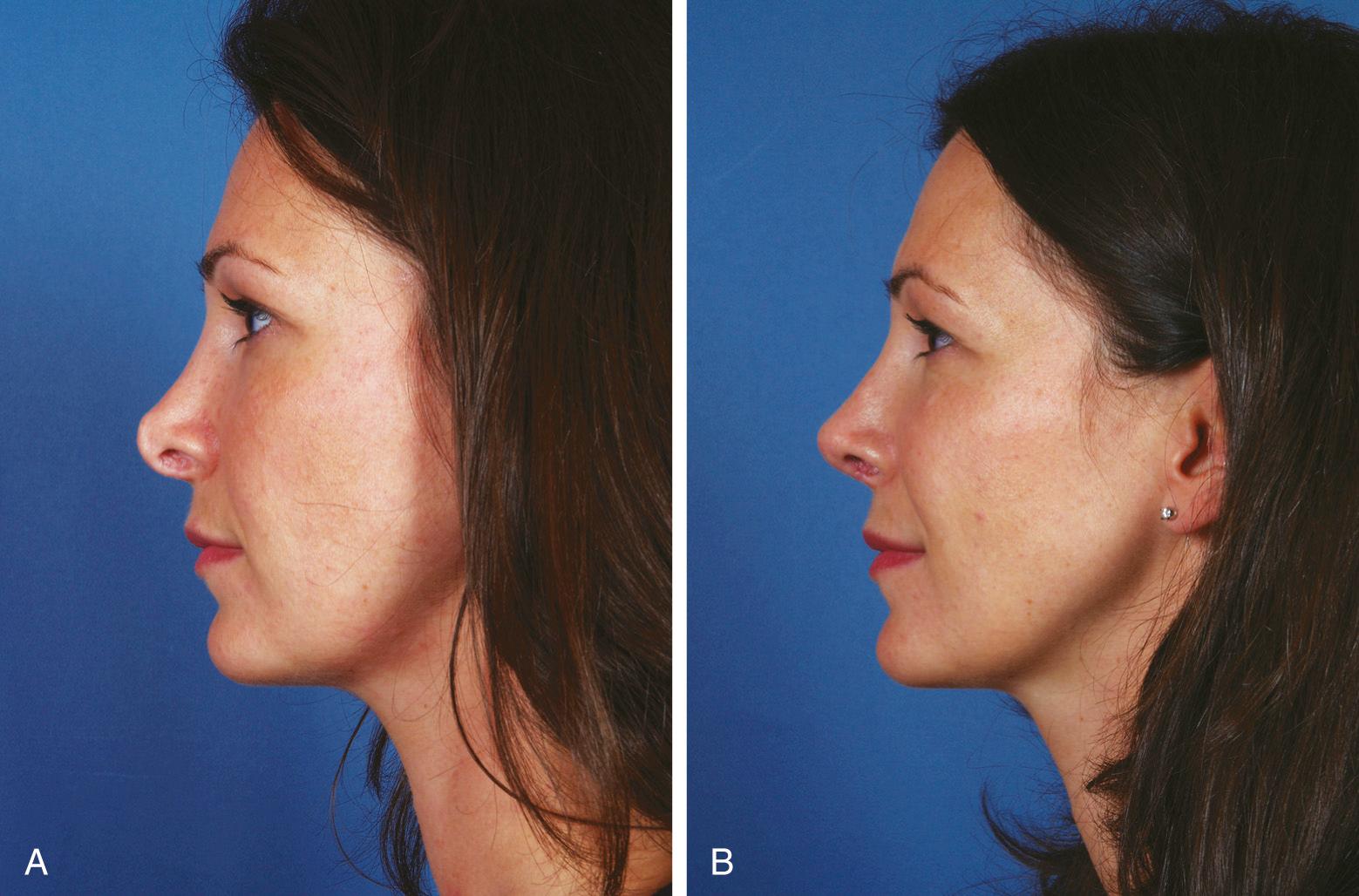
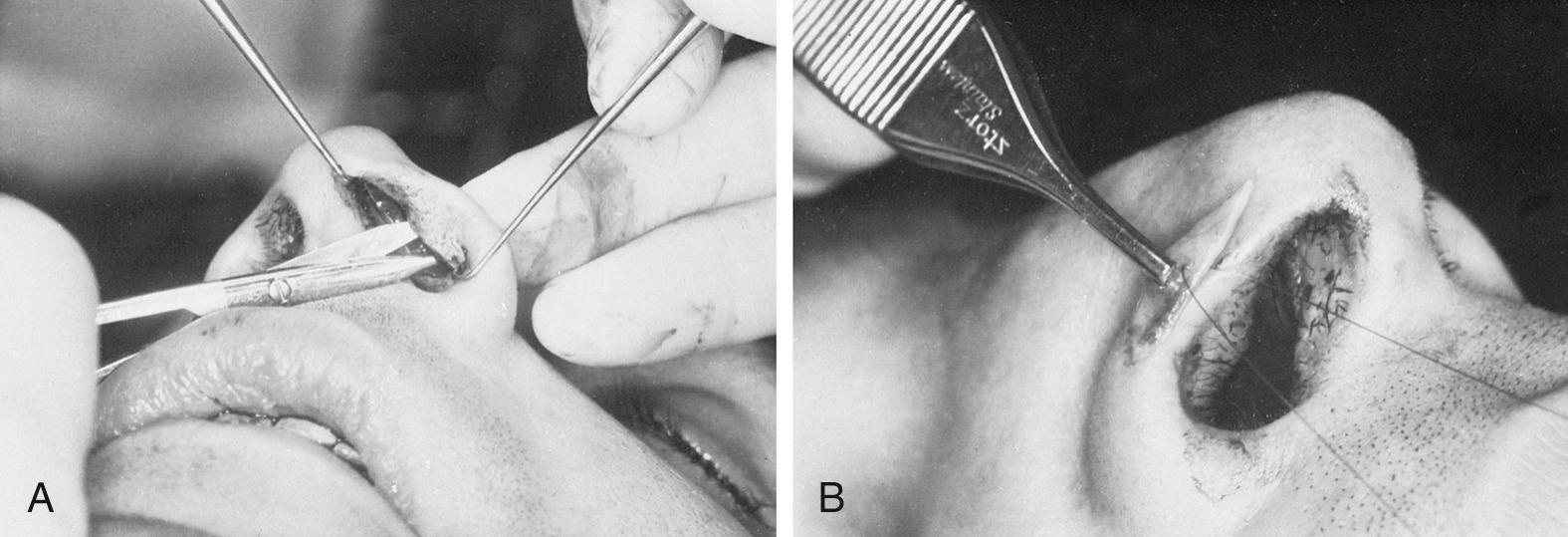
Columellar retraction, regardless of the etiology, must be addressed because it is the mainstay of support of the tip and the long-term success of rhinoplasty. Caudal septal extension grafts placed end to end or side to side are important to support, straighten, and reshape the tip and columella. They can be secured with the perpendicular plate of the ethmoid or polydioxanone (PDS) plates; they can be free standing or based on a premaxillary graft.
Subtle modifications in the nasofrontal angle can significantly enhance a patient's nasal and facial profiles. In patients with a shallow nasofrontal angle, the nose often appears to have excessive length, and a 2-mm osteotome can be inserted through a stab incision in the midline over the nasal bones ( Fig. 32.14 ). The nasal bones can be scored or weakened on either side with transverse osteotomies, thereby controlling the cephalic fracture site. This will allow the surgeon to control the site of the nasofrontal angle when the bony hump is removed. After removal, the angle may be smoothed or further deepened by the use of the rasp or rongeur.
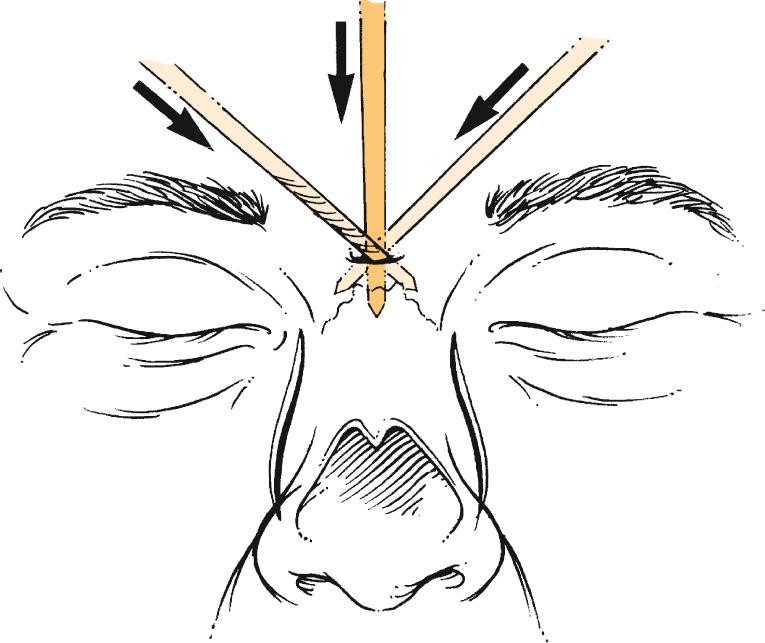
In patients with a deep nasofrontal angle, the nose often appears to be short and overprojected. In these patients, the nasofrontal angle can be augmented with autogenous cartilage, bone, or any of the alloplastic materials mentioned earlier. Autogenous cartilage is the material of choice because of its low rate of absorption and nonreactivity. A precise pocket should be made that does not allow movement of the graft, and the graft can be further stabilized by placing transcutaneous sutures through the graft and tying them over a bolster.
Become a Clinical Tree membership for Full access and enjoy Unlimited articles
If you are a member. Log in here